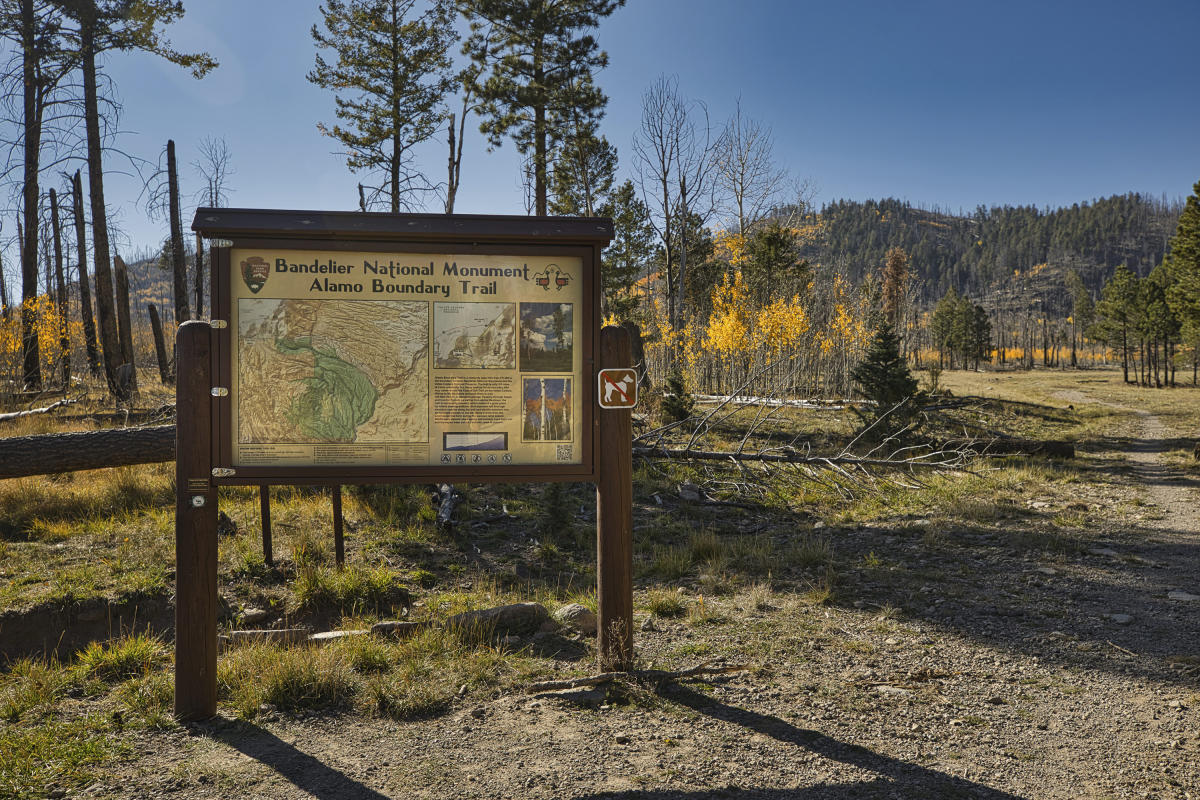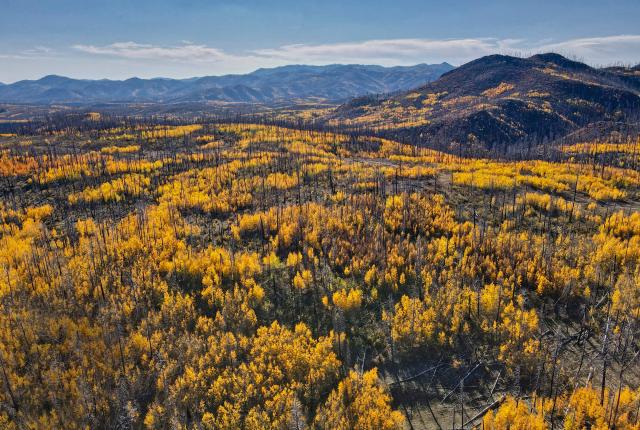Pockets of fall color glimmer across the charred ridges of the Jemez Mountains.
A FEW SLIM, BLACKENED PINE TREES—some now up to their waists in baby aspens—stand sentry on the ridgetops running off the western slope of the Jemez Mountains. In the autumn morning light, those stands of aspen turn to rivulets of yellow. Strips of Gambel oak crisped to shades of caramel, amber, and burgundy adorn other hillsides.
The aspens and oaks have been waiting for this. They lived under the shade of conifers for a century before the 2011 Las Conchas Fire burned more than 156,000 acres and opened the ground to full sun. Now the aspens glow so brightly they seem lit from within. Places that a decade ago were charred to a moonscape have grown back in a mosaic of fall colors.
“We try to make lemonade out of the loss of the forest by saying, ‘At least the oak and the locust are pretty in the fall,’ ” says Ellis Margolis, a researcher at the Fort Collins Science Center field station in Santa Fe, who studies fire ecology in the Southwest.
Learn a bit about wildfires and you’ll begin to read their history in the landscape. How they function, especially to deliver fall color, leads to a different future depending on your location in the woods. Some aspen groves are a natural part of the process, while others signal a system running off course.
On ponderosa pines, sections of light brown bark toasted to black show where mellow fires browsed through the undergrowth without troubling mature trees. Slice into their trunks,as some researchers do, and the rings record one fire after another. Margolis counted lines from 31 wildfires in one tree in the Jemez.
But there are also places where fire has rewritten the forest’s future. A century of fire suppression left so much undergrowth that some blazes now burn hot enough to kill even the oldest pines. The loss of mature trees over thousands of acres means no seeds for a next generation. A warmer, drier climate makes life tougher for a seedling, too.
“It’s a very complicated topic with the changes we’re seeing,” says Dennis Carril, a fire ecologist with the Santa Fe National Forest. “The one thing we can have consensus on is that fire is part of the landscape.”
With those changes, ponderosa pines may not return to some fire-scarred areas for decades or centuries, if ever. Instead, locusts, aspens, and oaks claim the ground, surging back from surviving root sources and leafing out over charred stumps larger than manhole covers.
 The Las Conchas Fire rewrote the future of Bandelier National Monument.
The Las Conchas Fire rewrote the future of Bandelier National Monument.
In the Jemez, the effects of the Las Conchas Fire—the largest wildfire in state history—can be witnessed by driving out FR 289 (Dome Road) or hiking the 2.9-mile Coyote Call Loop, in Valles Caldera National Preserve, or the 2.6-mile out-and-back Alamo Boundary Trail, in Bandelier National Monument. These routes traverse from pine forests at the edge of the burn scar into where the aspens, locusts, and oaks are taking over.
“There are some areas above Santa Fe that used to burn every five to 15 years, and they haven’t burned for 140 years,” Margolis says. “They’re just waiting. They will burn again; it’s a question of whether they’re going to burn hot and blow the whole place up or burn like they used to and not kill trees and leave scars.”
Among conifers found in New Mexico’s highest peaks, it’s a different story. Even before the U.S. Forest Service made extinguishing all wildfires official policy in 1910, fire rarely reached those trees. When it does, it takes out vast swaths of the forest. What comes after those fires is a reward each fall. Aspens, which have earned the moniker of the “phoenix tree” for their ability to quickly rebound after fire, are among the first to regenerate.
In places like Aspen Vista, near Santa Fe, the trail climbs through groves so big that they’re visible from the city. A big, hot wildfire burned through in the 1870s. But hike through those trees along the 6-mile Aspen Vista Trail or stop at the Aspen Vista Picnic Site, off the Santa Fe National Forest Scenic Byway, and you’ll see Douglas firs, white firs, and spruces edging their way up toward the canopy they’ll someday reclaim.
“Over decades to centuries, you have this process where that pattern repeats,” Margolis says. “The aspens need the conifers to come in and be the fuel that feeds the fire that clears the way for more aspens.”
Foresters realize that fire is inevitable and even necessary. So now people are working to bring it back to the landscape and to have some say in when and where it burns.
After a prescribed burn off Pacheco Canyon Road, near Santa Fe, most of the ponderosa pines are still thick with green needles that sing along with the wind. Gambel oaks reach knee height, thick with copper-colored leaves that rustle against themselves. Patches of sky shine through the thinned understory.
“If we don’t cut and burn and return fire,” says Carril, “you’re going to have something like Las Conchas that comes through and changes things for maybe not forever, but for a long time.”
In those transformed groves in the Jemez, all the creased ridgelines that a forest would have covered are instead clearly visible and filled with pink light as the sun sets.


